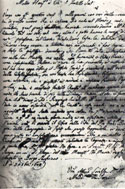| The 12 Letters of St. Mary Magdalene de' Pazzi | |||
 |
Introduction to the Letters | ||
| In the span of 40 days,
between July 25 and September 4, 1586, Sr. Mary Magdalen de' Pazzi
dictated 12 letters which have survived to this day. Each is a passionate
appeal for the urgent renewal of the Church and of religious life in the
Church. Each was dictated while the saint was in ecstasy. |
|||
|
.
. . |
|||
| Only the 9th letter is known
to have been read by the intended party. Written to her friend, fellow
ecstatic, and future
saint Catherine de' Ricci , Mary Magdalen received a response with words of caution. On the
topic of reform, Ricci advised the Carmelite nun to consult her spiritual
director. That letter is still preserved in the archives of the monastery
of St. Mary of the Angels. The content of most of the other eleven letters probably came to be known. by their intended recipients because they had connections to the monastery. It is fairly certain that the letter to Pope Sixtus and the letter to the Cardinals of the Roman Curia never left the enclosure of the monastery and remained unknown to their recipients. The letters were only published in an unabridged form for the first time in 1884, almost 300 years after they were dictated. |
|||
|
.
. . |
|||
|
The 12 letters share a series of common themes:
|
|||
|
.
. . |
|||
|
Born in 1566, Catherine de' Pazzi was destined to live during one of the more difficult periods in the history of the Catholic Church. Entering the enclosed Carmelite monastery of St. Mary of the Angels in Florence, Italy in 1583, she took the name Mary Magdalen. The Florentine monastery was frequently a gathering place for women of the court of Florence-- among them the future wife of Henry IV of France. Others more familiar with the lives of the common people passed through as well, giving the saint the opportunity to remain very familiar with the problems of daily life outside the monastery. Recipient of mystical experiences accompanied by extermal phenomena for some of her religious life, Mary Magdalene lived and suffered with uncommon depth the joys and harshness of the contemplative life. |
|||
|
.
. . |
|||
| She was very aware of the evils that afflicted religious and church
life of her time and became an ever stronger advocate for renewal with the
Catholic Church. She preferred "renewal" to "reform" which brings with it
a sense of contentious denouncement, of protest, and of struggle with the
official church. Rather, Mary Magdalen was more interested in a renewal
that focused on "conversion" of the heart. This was a common theme of the
Church of the day, always being called to re-birth and the self-renewal,
to change the interior ways, stained and contaminated by the world in
which it existed. |
|||
|
.
. . |
|||
| Sr. Mary Magdalen was also influential in bringing about a greater austerity in the lives of the sisters, changes which were incorporated in the monastery's constitutions of 1610. | |||
|
.
. . |
|||
| from: The Carmelites: The Post Tridentine Period 1550-1600 (vol III) by Joachim Smet, O. Carm. La rinnovazione della Chiesa Lettere dettate in estasi Cittą Nuova - Edizioni O.C.D. © 1986 ISBN 88-311-4804-4 |
|||